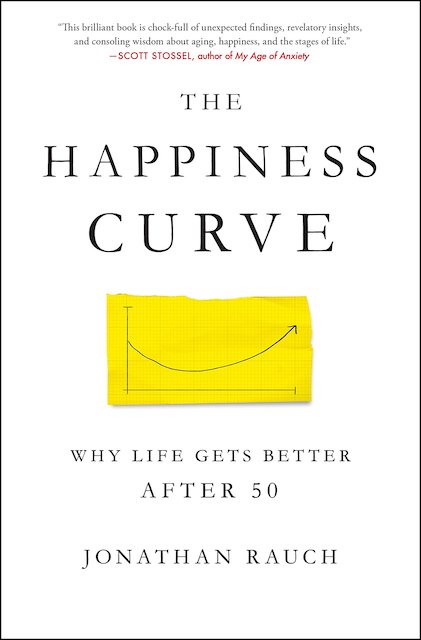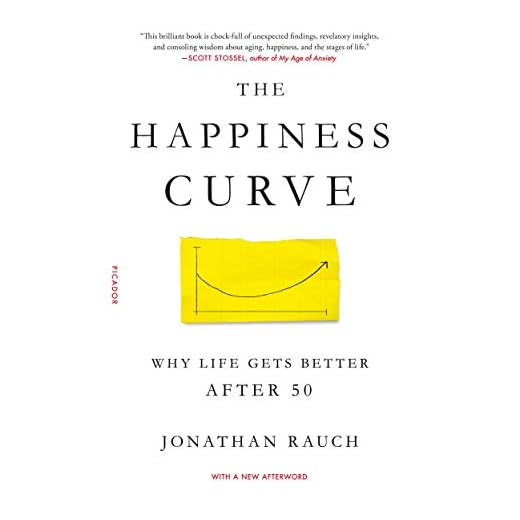The Happiness Curve book review reveals why life gets better after 50. The book is by Jonathan Rauch. An uplifting book that argues that society’s ageism is preventing us from enjoying this transition period in life.
‘Most of what people think they know about happiness and aging is wrong and is hurting them. The term Midlife Crisis was first described by a psychoanalyst in 1965.
However, in 2004, economists David Blanchflower and Andrew Oswald found that age was a determinant of happiness.
They explained a U-shaped relationship between life satisfaction and age, with the bottom of the curve occurring in the early 50s.

The Happiness Curve Will Change Your Life
In this fascinating and uplifting book, US journalist Jonathan Rauch talks to scientists and ordinary people who have experienced the “midlife slump” or even “midlife reboot.”
Rauch argues convincingly that a normal transition, like adolescence, leads to a more stable, positive stage of life.
But ageism is widespread. Jonathan Rauch challenges negative stereotypes about older workers and argues that such prejudices prevent us from coping with midlife and beyond:
“Most of what people think they know about happiness and aging is wrong and is hurting them”.
Jonathan Rauch
Now in his late 50s, Rauch says, writing this book has made him more optimistic about the future:
“Ageing equips us to be happier and kinder.” Old age can be the most satisfying period of life, “a gift the likes of which mankind has never known before”.
Why does happiness get more complex in our 40s? Why do you feel in a slump when you are successful? From where does this despair come?
And, most importantly, will it ever end? The Happiness Curve: Why Life Gets Better After 50 by Jonathan Rauch is the book that answers all these questions.
“In this warm, wise, and witty overview, Jonathan Rauch combines evidence and experience to show his fellow adults that the best is yet to come.”
Steven Pinker, bestselling author of Enlightenment Now
So, let us get to the Happiness Curve Book Review.
Tell me what I thought when I first came across this title. I was very skeptical to think that there is such a thing as a happiness curve, let alone happiness starts after 50!!
I am well into my 50s, and this book addresses this range. So, I had to read it and decide if the curve mentioned is actual or just another book on the market!
In my opinion, this is Jonathan Rauch’s most impactful work. His writings are clear, concise, persuasive, and compelling. He explored the most elusive of goals: happiness.
Rauch spoke from his own experience and that of many others with whom he spoke. He explains why we endure a mid-life slump, which is thankfully followed by a happier mood after we reach 50.
How Does Life Change?
Rauch reassures all of us that our slump has less to do with our accomplishments and more to do with the regular rhythms of human existence.
So, relying heavily on extensive research, the book offers hope that better days await us as we age.
Jonathan Rauch believes that these questions are not about a midlife crisis. Rauch reveals that this slump is instead a natural life stage—an essential one.
Shifting your priorities away from the competition and toward compassion equips you with new tools for wisdom and gratitude to win the third period of life.
The Happiness Curve: Why Life Gets Better After 50
$14.59 in stock
33 used from $2.46
What is the Happiness Curve?
Drawing on cutting-edge research, award-winning journalist Jonathan Rauch answers all these questions.
He shows that from our 20s into our 40s, happiness follows a U-shaped trajectory, a “happiness curve,” declining from the optimism of youth into what’s often a prolonged, low slump in middle age before starting to rise again in our 50s.
Furthermore, Rauch testifies that his slump compelled him to investigate the happiness curve despite his acclaim as a journalist and commentator.
Rauch’s own story explains how the ordeal of midlife discomfort reboots our values and brains for rebirth and gratitude.
Rauch’s story is not unique by all means. Rauch claims he is not the only one who has this story. Many others from different walks of life―a steelworker, a limo driver, a telecoms executive, and a philanthropist, have the same experience.
The happiness Curve is full of insights and data and features many ways to endure the slump and avoid its perils and traps.
Why Life Gets Better After 50 does not just show you the dark forest of midlife; it helps you find a path through the trees.
The book also demonstrates how we can―and why we must―do more to help each other through the woods. Midlife is a journey we mustn’t walk alone.
My Take on The Book
The Happiness Curve is, without question, the most important book I have ever read. Jonathan wrote it like a detective novel but in a non-fiction format.
The book combines insights from many experts, such as economists and psychologists, to answer a question that has baffled humankind for ages.
The problem concerns people who feel worse as they age, regardless of their health, income, or social status. However, when they reach their 50s, they feel more satisfied with their lives.
I recommend this book to everyone, regardless of age. It would be best if you read this book. If you are under 50, it will warn you of the potentially rocky times ahead.
However, if you are beyond these trying times, you will finally understand what you couldn’t explain or why you felt the way you did.
I couldn’t put this book down; I wanted to finish this masterpiece. Just remember, happiness looms, so do not despair. There are similar lessons for the rest of us. Please do not wait; buy this book, and thank me later.
Who knew that the midlife crisis was the gateway to a happier life? The Happiness Curve is a well-written, uplifting work of research and reality, passion, and humanity. Read it, and you will be pleased you did.
More Johnathan Rauch Books are available here on amazon.

